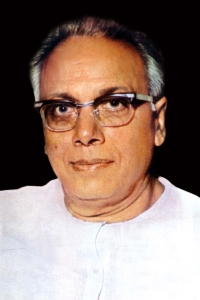Sudini Jaipal Reddy (
Telugu: సూదిని జైపాల్ రెడ్డి) (born 16 January 1942) is a member of the 15th
Lok Sabha of
India. He represents the
Chevella constituency of
Andhra Pradesh and is a member of the
Indian National Congress. He served as a Union Minister for Information and Broadcasting in
IK Gujral cabinet in 1998. In 1999 he returned to
Indian National Congress after 21 years. In 2004 he was re-elected to 14th
Lok Sabha from
Miryalguda Constituency and then he served as a Union Minister for
Information and Broadcasting and Union Minister for
Urban Development in
UPA-1. In 2009 he was re-elected to the 15th
Lok Sabha from
chevella constituency and served as a Union Minister for
Urban Development and Union Minister for
Petroleum and Natural Gas. He is presently the Union Minster for
Science and Technology and Earth Science's from 29 October 2012 in UPA-2.
Early life
Jaipal Reddy was in born Nermatta, a Village in Chandur Mandal in
Nalgonda District in Andhra Pradesh State, but is actually from
Maadgula, Mahbubnagar district in AP. He has an
M.A. from the
Osmania University,
Hyderabad. He is physically
disabled and uses
crutches.
Career
Jaipal Reddy was an
MLA of
Kalwakurthy
between 1969 and 1984, a constituency in Andhra Pradesh for four terms.
He was a member of the Congress Party but quit to protest against the
emergency and joined the
Janata Party in 1977.
He contested the 1980 Lok Sabha elections unsuccessfully from
Medak against
Indira Gandhi.
He was the general secretary of the Janata Party from 1985 to 1988. He
was elected to the Lok Sabha five times: the 8th Lok Sabha in 1984 (in
alliance with
TDP), the 12th in 1998 (again as ally of TDP), the 13th in 1999 (as a member of the Congress Party), the
14th in 2004 (as a member of the Congress Party,
Miryalaguda constituency) and the
15th in 2009 (as a member of the Congress Party). He was also a member of the
Rajya Sabha on two occasions, 1990–1996 and 1997–1998.
He also held the position of leader of opposition in the Rajya Sabha
for a year from June 1991 to June 1992. In 1999–2000, he was the
Chairman of Committee of privileges. He served as the minister for
Information and Broadcasting in the
government on two occasions: in 1997–1998 under
I. K. Gujral and from 2004 under
Manmohan Singh with additional responsibility for Culture. He also served as the minister for Urban Development and Petroleum and Natural Gas.
A unique facet of his political career has been that he acted as the
spokesman for all the parties of which he has been a member. He is known
for the quality of his debates in the
parliament and was awarded the
Outstanding Parliamentarian Award in 1998. He was the first from South India and the youngest parliamentarian to achieve this award.
Positions Held
- Elected twice as President, Osmania Students Union, Osmania University
- 1965–71 President AP Youth Congress
- 1969–72 General secretary, Andhra Pradesh Congress Committee
- 1969–84 Member, Andhra Pradesh Legislative Assembly (4 terms)
- 1979–88 Member, National Executive, Janta Party
- 1984 Elected to 8th Lok Sabha
- 1985–88 General secretary, Janta Party
- 1990–96 97–98 Member Rajya Sabha
- July 1991 – June 1992 Leader of Opposition, Rajya Sabha
- 1997–98 Union cabinet minister ( I & B)
- 1998 Re-elected to 12th Lok Sabha (second term)
- 1998–99 Member, Committee of Finance,Consulative Committee Ministry of Finance
- 1999 Re elected to 13th Lok Sabha (third term)
- 1999–2000 chairman Committee of Privileges,Member Committee of Finance,Joint Committee of Patents
- 2000–2004 Member Consultative Committee, Ministry of Power
- 2004 Re elected to 14th Lok Sabha (fourth term)
- May 2004 – Nov 2005 Union cabinet minister, Information & Broadcasting
- Nov 2005 Union cabinet minister, Urban Development.
- Vice-President, Parliamentary Forum on Water Conservation & Management
- Jan 2006 Union cabinet minister, Urban Development,Vice-President Parliamentary Forum on Water Conservation Management
- 2009 Re elected to 15th Lok Sabha (fifth term)
- May 2009 – Jan 2011 Union cabinet minister, Urban Development
- Jan2011 – Oct 2012 Union cabinet minister,Petroleum and Natural Gas
- Oct2012 – present Union cabinet minister, Science and Technology, Earth Sciences.
Removal from the Oil Ministry
The last
cabinet reshuffle
of the UPA-II government took place on 28 October 2012. Jaipal Reddy
known for his honesty was shifted from his current ministry to the
Science and Technology ministry. The oil ministry had imposed a fine of
7000
Rs.
crores on
Mukesh Ambani's company for the sharp drop in production of gas and violations mentioned in
CAG's 2011 report. Further, the oil ministry did not approve company's US$7.2 billion stake in deal with
BP.
[1][2] The rival parties including the
BJP,
SP, and
Arvind Kejriwal said that he was removed owing to alleged pressure from the corporate houses, particularly from the
Reliance group of Industries. However he refuted the claims and said that he needs to understand the new portfolio.
[3][4][5]
Achievements
Personal life
Shri Jaipal Reddy's earlier profession was of an agriculturist. His
favourite pastime is reading and is known to have visited many
countries. He married Smt. Lakshmi on 7 May 1960. He has two sons and
one daughter.
[6]
 |
| MP |
| Constituency |
Chevella |
| Personal details |
| Born |
16 January 1942 (age 71)
Madgul, Andhra Pradesh |
| Nationality |
Indian |
| Political party |
Indian National Congress |
| Spouse(s) |
Lakshmi |
| Children |
2 sons and 1 daughter |
| Residence |
Maadgula |
| Religion |
Hinduism |





